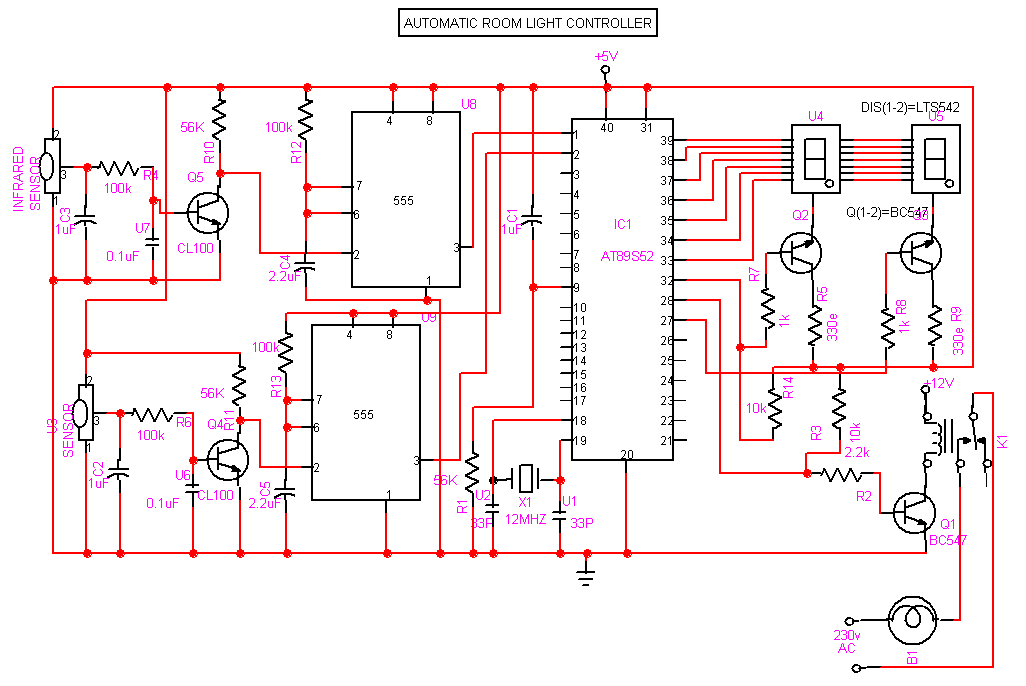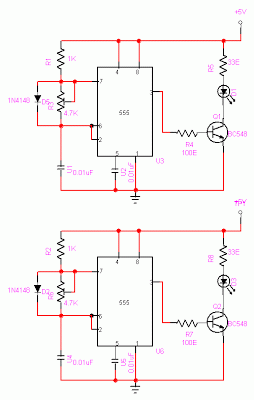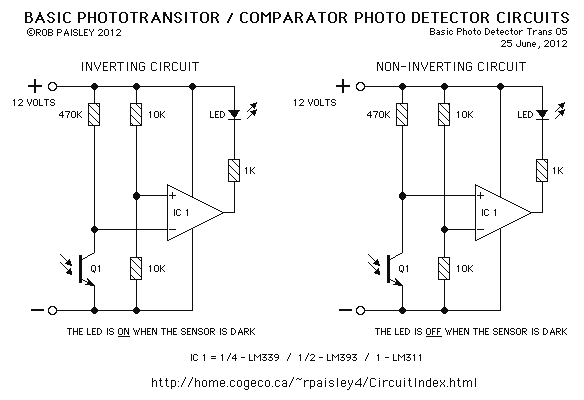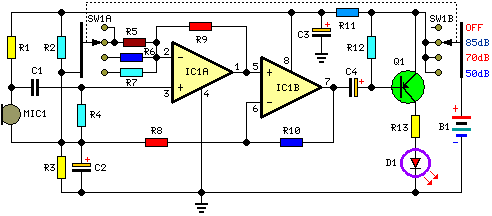
Room Noise Detectors
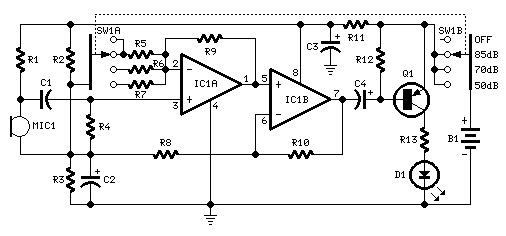
This circuit is designed to indicate through a flashing LED when room noise exceeds a predetermined threshold, selectable from three fixed levels: 50, 70, and 85 dB. Two operational amplifiers (op-amps) are utilized to amplify the sound captured by a miniature electret microphone, which in turn drives the LED. The circuit can be powered on or off using switch SW1, with its second, third, and fourth positions corresponding to input sensitivity thresholds of 85, 70, and 50 dB, respectively. The 50 dB setting is specifically intended for monitoring nighttime noise levels in a bedroom. A steady or frequently flashing LED indicates that the noise level is too high for conducive sleep.
The circuit operates by utilizing a miniature electret microphone to convert sound waves into electrical signals. These signals are then fed into a pair of operational amplifiers configured for gain, allowing for the amplification of the sound levels detected by the microphone. The output from the op-amps is compared against the fixed thresholds set by the positions of switch SW1.
When the input sound level exceeds the selected threshold, the circuit activates the LED, which will flash to indicate the excessive noise level. The LED serves as a visual alert, providing immediate feedback to the user regarding the noise environment. The choice of thresholds at 50, 70, and 85 dB allows for flexibility depending on the specific needs of the user, with the 50 dB setting being particularly useful for monitoring low noise levels during sleep hours.
The operational amplifiers are configured in a non-inverting amplifier setup, providing the necessary gain to ensure that even quiet sounds can be detected and processed effectively. The design may also include additional components such as resistors and capacitors to filter noise and stabilize the circuit, ensuring reliable performance.
Overall, this circuit serves as a practical tool for monitoring ambient noise levels, particularly in environments where quiet is essential, such as bedrooms during the night.This circuit is intended to signal through a flashing LED, the exceeding of a fixed threshold in room noise, chosen from three fixed levels, namely 50, 70 & 85 dB. Two Op-amps provide the necessary circuit gain for sounds picked-up by a miniature electret microphone to drive a LED.
With SW1 in the first position the circuit is off. Second, third a nd fourth positions power the circuit and set the input sensitivity threshold to 85, 70 & 50 dB respectively. The 50 dB setting is provided to monitor the noise in the bedroom at night. If the LED is steady on, or flashes bright often, then your bedroom is inadequate and too noisy for sleep.
🔗 External reference
The circuit operates by utilizing a miniature electret microphone to convert sound waves into electrical signals. These signals are then fed into a pair of operational amplifiers configured for gain, allowing for the amplification of the sound levels detected by the microphone. The output from the op-amps is compared against the fixed thresholds set by the positions of switch SW1.
When the input sound level exceeds the selected threshold, the circuit activates the LED, which will flash to indicate the excessive noise level. The LED serves as a visual alert, providing immediate feedback to the user regarding the noise environment. The choice of thresholds at 50, 70, and 85 dB allows for flexibility depending on the specific needs of the user, with the 50 dB setting being particularly useful for monitoring low noise levels during sleep hours.
The operational amplifiers are configured in a non-inverting amplifier setup, providing the necessary gain to ensure that even quiet sounds can be detected and processed effectively. The design may also include additional components such as resistors and capacitors to filter noise and stabilize the circuit, ensuring reliable performance.
Overall, this circuit serves as a practical tool for monitoring ambient noise levels, particularly in environments where quiet is essential, such as bedrooms during the night.This circuit is intended to signal through a flashing LED, the exceeding of a fixed threshold in room noise, chosen from three fixed levels, namely 50, 70 & 85 dB. Two Op-amps provide the necessary circuit gain for sounds picked-up by a miniature electret microphone to drive a LED.
With SW1 in the first position the circuit is off. Second, third a nd fourth positions power the circuit and set the input sensitivity threshold to 85, 70 & 50 dB respectively. The 50 dB setting is provided to monitor the noise in the bedroom at night. If the LED is steady on, or flashes bright often, then your bedroom is inadequate and too noisy for sleep.
🔗 External reference
